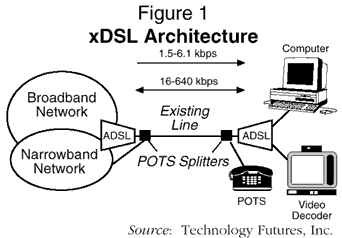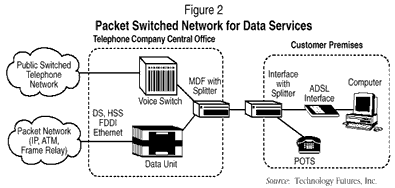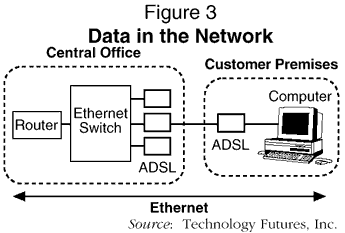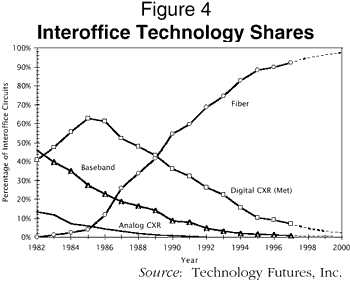
Digital subscriber line (xDSL) is one such emerging technology under evaluation that, while not a panacea to bandwidth problems, can provide a very timely and beneficial short- to medium-term solution. xDSL provides an alternative to the existing POTS or ISDN line between the subscriber and the local access switch. It typically provides:
Figure 1 illustrates a typical xDSL architecture.

xDSL has received a lot of press and is in many trials, but does it have a future, and what will it take to make it a market success? This article will consider the future of xDSL technologies and potential market opportunities. A number of different xDSL technologies will be discussed, but the primary focus will be on Asymmetrical Digital Subscriber Line (ADSL).
POTS lines had previously been deemed unsuitable for broadband communications, yet these ordinary twisted copper pairs, when equipped with xDSL modems, can transmit movies, television signals, graphics, and high-speed data. xDSL is being proposed in several versions that vary in both bandwidth and reach, as illustrated in Table 1. The most popular version, ADSL, offers a 200-fold increase in throughput over today's fastest analog modems. Some versions are asymmetrical with differing data rates running in each direction, i.e., in the downstream and upstream directions. Others are symmetrical, providing the same data rate both upstream and downstream. With almost 600 million telephone lines in the world today, there is certainly ample market opportunities for xDSL technologies. These technologies also offer an advantage over fiber- or coax-based technologies, which are both very costly to deploy.
| Table 1: xDSL Technologies | |||
|---|---|---|---|
| Name | Meaning | Data Rate | Mode |
| DLS | Digital Subscriber Line | 160 Kb/s | Duplex |
| HDSL | High Data Rate Digital Subscriber Line | 1.544 Mb/s 2.048 Mb/s | Duplex |
| ADSL | Asymmetrical Digital Subscriber Line | 1.5 to 9 Mb/s 16 to 640 Kb/s | Down Up |
| VDSL* | Very High Data Rate Digital Subscriber Line | 13 to 53 Mb/s 1.5 to 2.3Mb/s | Down Up |
| IDSL | ISDN Digital Subscriber Line | <128 Kb/s | Duplex |
| * Also called BDSL and VADSL | |||
| Source: Technology Futures, Inc. | |||
Because it can quickly and cost effectively meet the needs of users who want more bandwidth on demand now, ADSL is extremely promising as an interim solution. According to a story in PC Week (August 26, 1996), there will be five million ADSL lines installed by the year 2000. With 600 million telephone lines worldwide, this will hardly make a dent in ever-growing demands for greater, faster bandwith.
Several key points to remember about ADSL are:
RATE ADAPTIVE ADSL (RADSL)
Some providers, like Bell Atlantic and NYNEX, are experimenting with a more advanced form of ADSL--Rate Adaptive ADSL (RADSL)--which saves the expense of having to qualify the local loop for the higher speeds. This qualification could include, for example, the quality of lines, subscriber distance from the central office, load coils on the lines, bridge taps, and the number of existing splices. The speed of RADSL is determined by the capabilities of the copper pair which adjusts to line quality much like a data modem does today. When you look at the other digital options such as T1/E1 and PRI-ISDN, they either work or they don't work. In contrast, the RADSL technology can function on less than optimum lines. However, there is a tradeoff in that there will be some loss in signal speed.
ISDN DIGITAL SUBSCRIBER LINE (IDSL)
ADSL technology is also being adapted to work with existing technologies. For example, Ascend Communications has developed an ISDN Digital Subscriber Line or IDSL. To the home or business user, it looks exactly like a 128 Kb/s ISDN connection. However, unlike BRI-ISDN, it is a data-only connection, so it does not need to connect through a central office voice switch. MFS Communications is currently introducing this service to its customer base. Ascend believes that running IDSL over existing ADSL technology will enable users to deploy ADSL a lot cheaper and faster because there already exists a fair amount of software which supports ISDN standards.
The Ascend IDSL technology addresses one of the largest impediments to wide-scale data deployment over the public telephone network today--it creates a packet network, separate from voice calls, for more efficient transport. The average data call typically lasts much longer than the voice calls for which the central office switches were designed. Internet access has inflated the average call duration from approximately three minutes to about 20 minutes, with some calls lasting several hours according to Bell Communications Research (Bellcore). The use of IDSL enables users to bypass the CO switch entirely which, in turn, allows service providers to conserve switch resources and reduce network congestion.
Carriers face two choices:
Some carriers have estimated a 10-fold increase in costs to upgrade the existing public switched network to handle the increasing demand from both voice and data users. Consequently, offloading data traffic is the only solution that really makes sense. xDSL does just that (see Figure 2).

ADSL NETWORKS
ADSL installations, in which the technology supports a wider network of users, are also beginning to emerge. This type of usage enables xDSL technologies to compete head-on with other wideband technologies such as T-1, Primary Rate ISDN, and private networks. For example, at this year's Global Networking 1997 trade show in Calgary, Netspeed and TELUS demonstrated an ADSL network that used speed routers which supported both IP and IPX routing, Rate Adaptive xDSL configuration, as well as firewall support. They demonstrated a connection speed that ran at 7 Mb/s downstream and 1 Mb/s upstream.
DSL ACCESS MULTIPLEXERS (DSLAMS)
The other big change in ADSL technology is the evolution from ADSL modems between the subscriber and the local access switch to DSL Access Multiplexers (DSLAMs) which reside between central offices. One of the drivers for this is the influx of smaller carriers including competitive local access carriers and Internet service providers entering this marketplace. AG Communications, PairGain Technology, and ALCATEL are just some of the companies beginning to offer these products. DSLAMs are also beginning to interface with other protocols. For example, PairGain has a special access gateway for its DSLAM which provides encapsulated bridging of Ethernet packets, and Paradyne has frame relay integrated into its ADSL access.

Suppliers are beginning to look at market niches for adding value to xDSL technologies. AG Communications has released a product which integrates four separate 10-base-T ports on a unit with both an ADSL line interface and a POTS splitter. They are targeting the small office/home office (SOHO) users who want the ADSL modem for local area networks. This competes directly with ISDN units, such as the Ascend Pipeline 85, but at a higher data speed.
Long distance carriers and competitive access providers are also beginning to deploy xDSL technologies. Symmetrical high-speed services such as HDSL (symmetrical, 768 Kb/s) and SDSL can be provisioned and priced lower than comparable T1/E1 or fractional services. Because these services are tariffed at lower prices for equal bandwidth, they could serve as the access ramp for businesses to their local and long distance calling and Internet data services.
Digital subscriber line is also creeping into the public network and is likely to become more pervasive over the next couple of years as volume drives the prices down. xDSL deployments currently use IP protocol routing equipment and frame relay networking. Major carriers plan to use Asynchronous Transfer Mode (ATM) in the future, which will be a much more effective way to handle large amounts of data. In fact, the ADSL Forum has been working on a specification for ATM over ADSL for some time.
As seen in Figure 4, for the most part, the interoffice cable will be fiber; therefore, the real market opportunity is outside the interoffice network.

The race to develop xDSL technologies versus cable modem technology has opened many opportunities. The problem that may well define the non-business access market will revolve around the quality of the subscriber's inside wiring and separation of data and voice traffic. A POTS splitter will be necessary at each end if voice and data traffic share the same line. Of course, the question of who will provide the equipment and inside wiring is still very open.
It is possible that 1998 will be the year that many of the questions concerning xDSL deployment will be answered. There will be many service announcements as companies begin to determine how to best utilize this technology in the public network. To sum it up, the infrastructure is there, the switching equipment is there, and the end user equipment is there. What is missing is a plan to move forward to meet the demand for the bandwidth.